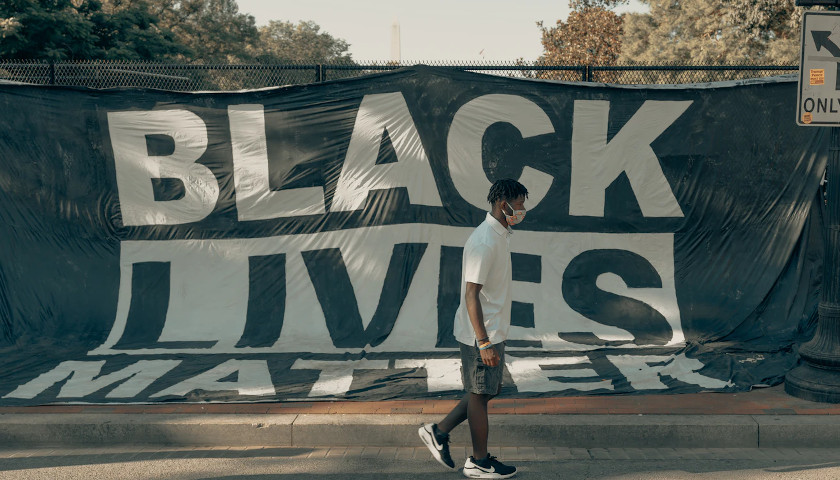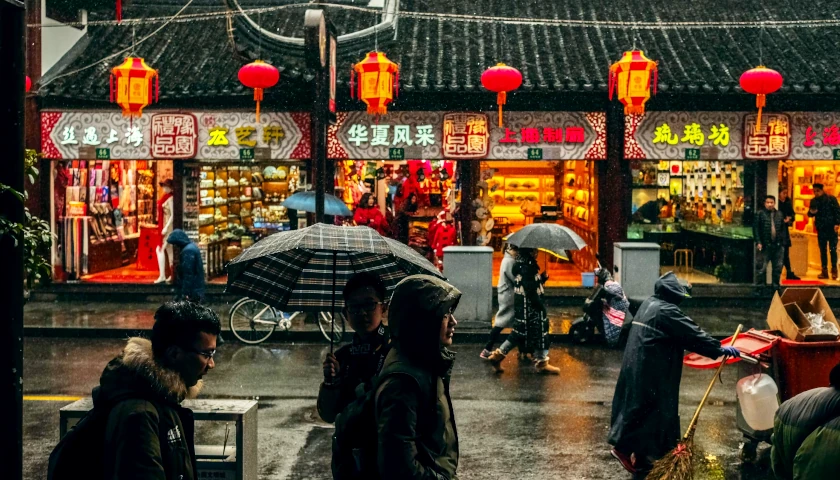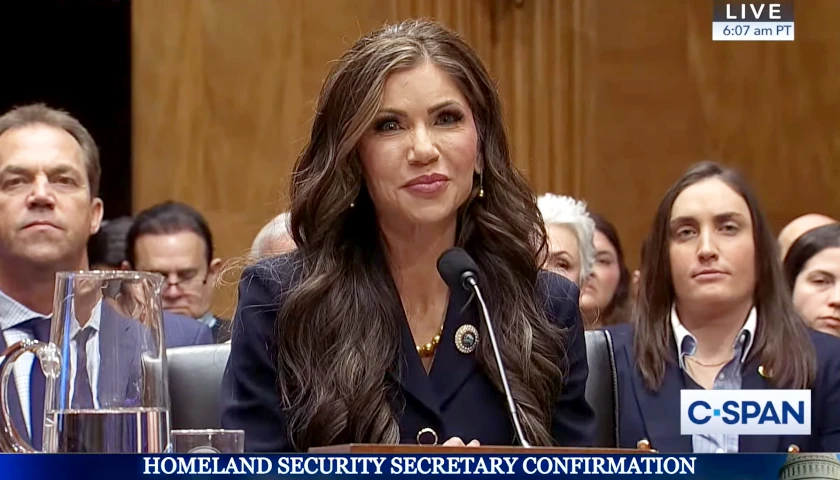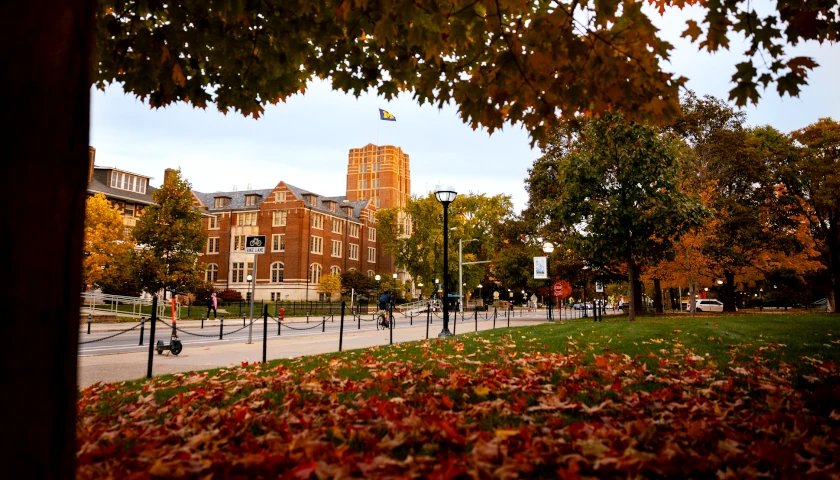by Kevin Mooney
Standing behind vandals who attempted to pull down the bronze statue of Andrew Jackson near the White House last week is a loosely configured, increasingly well-funded network of Black Lives Matter activists bent on constraining and defunding law enforcement.
An area called Black Lives Matter Plaza became the staging ground for more than 100 demonstrators, many of them egging on the vandalism before police intervened.
D.C. Mayor Muriel Bowser, a Democrat, gave the official name to the two-block section of 16th Street NW two weeks earlier. Bowser had city workers neatly paint “Black Lives Matter” on the pavement in yellow, using large capital letters, and put up new street signs identifying Black Lives Matter Plaza.
Groups across the country say they identify with the movement. A centralized organization called Black Lives Matter Global Network Foundation, however, has more than a dozen official chapters in the U.S. and Canada—including the District of Columbia—with shared goals and objectives.
In an interview with The Daily Signal, a leader of the Black Lives Matter chapter in Denver said the chapters operate independently and pursue agendas that are particular to their location.
“There are other groups that don’t follow guiding principles, and we don’t endorse those as part of the global network,” spokesperson Apryl Alexander said in the interview. “Those chapters listed on the website are following guiding principles, but they each operate independently, and in Denver we have our own organizational structure.”
As previously reported by The Daily Signal, the declared principles of the Black Lives Matter Global Network Foundation include advancing the LGBT political agenda and abolishing the nuclear family.
Alexander readily acknowledged that the Denver chapter is “looking at nontraditional or kinship families.”
Such goals may or may not be why demonstrators across America carry signs and wear accessories declaring that “Black Lives Matter” and spray-paint the initials BLM on defaced or toppled statues.
For such a young movement, its impact appears to be everywhere. Corporations and foundations are shoveling money its way, perhaps without understanding the movement’s broader stated goals.
Here’s a closer look at the history, structure, and financing of Black Lives Matter.
Chapters in 12 States Plus D.C.
What devolved into an attack on the 167-year-old statue of Jackson, the war hero who became the nation’s seventh president, began as another protest in Lafayette Square of the May 25 death of George Floyd, a black man, at the hands of a white police officer during his arrest in Minneapolis, Minnesota.
Although Black Lives Matter is back in the media eye since Floyd’s death, the movement’s organization, structure, and finances remain somewhat nebulous.
The main website identifies 12 state chapters in the U.S., one in the nation’s capital, and three in Canada. Besides the Black Lives Matter Global Network Foundation, variations of the name include Black Lives Matter Foundation and the Movement for Black Lives.
The regional chapters provide insight into how the self-described “collective group of liberators” working to “eradicate white supremacy” connects with a larger organization.
The chapter in Washington, D.C., for instance, identifies Aaron Goggans as a co-creator who has posted online articles under the banner of “personal reflections,” “lessons learned,” and an “emerging analysis of the movement.” Various media outlets have identified Goggans as a Black Lives Matter organizer.
Goggans has worked with the Latino Economic Development Center, the Coalition for Nonprofit Housing and Economic Development, and the Employment Justice Center, according to Influence Watch. In media interviews, he described the problem of black-on-black crime as a “myth.”
The D.C. chapter’s website includes a lengthy appeal for money that attacks President Donald Trump as a “white nationalist” and Attorney General William Barr as a “white supremacist”:
Now that an explicit white nationalist is in office and a known white supremacist is running the Department of Justice, our work and our growing ecosystem must continue to expand in its scope and depth. We must continue to actively and publicly resist along with taking the long view. We must be prepared spiritually, emotionally, physically, and intellectually.
The Daily Signal emailed the D.C. chapter asking about its relationship with the larger Black Lives Matter Global Network Foundation, how many members it has, and whether online donations go directly to the chapter or are sent to another entity. The chapter had not responded as of publication of this report.
A Short History
Black Lives Matter, which has taken center stage in media coverage of protests against police tactics and “systemic racism,” first gained notoriety after the 2012 fatal shooting in Sanford, Florida, of Trayvon Martin, a black high school student.
George Zimmerman, then a 28-year-old neighborhood watch coordinator for his gated community, argued that he acted in self-defense in shooting Martin, 17. A jury acquitted Zimmerman of all charges in 2013.
Three activists who opposed the Zimmerman verdict popularized the phrase “Black Lives Matter” by using the hashtag #BlackLivesMatter on social media.
The group resurfaced in 2014 following the fatal police shooting of Michael Brown, 18, in Ferguson, Missouri. After reviewing the evidence, a grand jury decided not to indict the white police officer who shot Brown, who was black, shortly after Brown tried to grab the officer’s revolver in his police cruiser.
President Barack Obama’s Justice Department cleared the officer of any civil rights violations and found that he acted in self-defense, but the #BlackLivesMatter hashtag reemerged as a popular social media tool, as USA Today reported.
In cities across the nation, demonstrators carrying Black Lives Matter signs called for the killing of police officers—and a surge of deadly ambushes against officers followed the Ferguson officer’s acquittal.
Today, Black Lives Matter Detroit is sponsored by Allied Media Projects, and Black Lives Matter 5280 in Denver by the Rocky Mountain Peace and Justice Center.
Donations made to the two chapters are routed through and reported as donations to these fiscal sponsors, writes Robert Stilson of Capital Research Center, a Washington-based nonprofit that examines how foundations and charities spend money.
Allied Media Projects is a left-leaning nonprofit media strategy group based in Detroit. The nonprofit Rocky Mountain Peace and Justice Center says it is dedicated to “radically progressive personal and social change.”
The Daily Signal sought comment from both organizations on their financial relationships with Black Lives Matter. Neither had responded by publication time.
Stilson, who runs specialized projects for Capital Research Center, explains in a recent report why it is important to flush out such financial relationships.
“Fiscal sponsorship is an arrangement through which an organization that does not have its own IRS tax-exempt status can operate as a “project of an organization that does,” Stilson writes. “In the case of 501(c)(3) fiscally sponsored projects, this allows for tax-deductible donations.”
Capital Research Center’s team has published several recent reports analyzing how Black Lives Matter is structured.
Activism in Denver
The Daily Signal sent a message via Facebook to the Denver chapter and an email to the Detroit chapter asking about their affiliations with the larger Black Lives Matter network and how many members the chapters have.
The Detroit chapter did not respond, but the Denver chapter put The Daily Signal in touch with Alexander as its spokesperson.
Alexander, a clinical and forensic psychologist who is a professor at the University of Denver, discussed the chapter’s objectives and organizational structure in a phone interview.
Black Lives Matter 5280, she said, has about a dozen members and derives its name from Denver’s elevation of 5,280 feet above sea level.
The Denver chapter scored a significant victory June 19 when Colorado Gov. Jared Polis, a Democrat, signed into law a “police accountability bill” ending “qualified immunity,” a concept used to protect police officers from litigation.
“That’s a discussion that’s been happening nationwide,” Alexander told The Daily Signal. “We’ve been assisting in this effort in the past few weeks and with the bill signed into law, one of our demands has been answered.”
She said the Denver chapter of Black Lives Matter has three divisions: community wellness, economic justice, and education.
The “education squad,” Alexander said, works to dismantle what she calls the school-to-prison pipeline. It examines how education policies and procedures funnel “students of color” into the criminal justice system.
Alexander points to another Colorado measure, signed by Polis in March, that prohibits discrimination based on a person’s hairstyle.
“The bill recognizes that people, especially in black communities, are being fired from their jobs or displaced from schools for wearing their hair naturally,” Alexander said, adding:
This has been happening all over our country. Kids are being kicked out of school because policies were created to discriminate against their hair and displace them from school. When we displace kids from school, then what do they do? They might gravitate toward gangs or be placed in alternative schools with kids with more severe behavioral problems.
In Denver, Black Lives Matter 5280 updated a list of demands on its Facebook page that includes “no more violent attacks against protesters,” “immediate abolishment of ICE,” and the “closing of all privately owned detention facilities.”
Alexander also is a plaintiff in a lawsuit filed June 25 by the American Civil Liberties Union of Colorado against Denver and Denver County. The ACLU filed the suit on behalf of Alexander, eight others, and Black Lives Matter 5280, following demonstrations in late May and early June.
The ACLU “challenges the use of tear gas and ‘less-lethal’ weapons that police unleashed against nonviolent protesters who were demonstrating over the killings of Black men and women at the hands of law enforcement,” the legal group’s Colorado affiliate says on its website:
Dr. Alexander witnessed police officers launching tear gas into protesters without warning. A few hours later, she found herself trapped between two clouds of gas, coughing, eyes and throat burning and disoriented. A day and a half later her face continued to burn. The police attack forced her to leave the demonstration, cutting short her ability to exercise her First Amendment rights.
‘Saddened and Angered’ in Detroit
Most of the U.S. and Canadian chapters have not updated or refreshed their websites to comment on events such as the spread of Floyd-related protests, calls to defund police, and vandalism of statues and monuments, with some exceptions.
Black Lives Matter Detroit, for example, announced a new “Virtual Event Schedule” and noted:
We are saddened, angered, but unfortunately unsurprised by recent police actions against Black Americans. While we did not organize last weekend’s protest actions, we fully support the Detroiters who came to speak truth to power.
The Detroit chapter also offers a definition of what is meant by “Black Lives Matter”:
We mean that the current societal intersection of governance and commerce was built upon a legacy of implicit bias; one that values the lives of Black bodies as inherently less than our white counterparts.
Or, said a different way: Our Society was built to be intentionally racist!
Our society was built this way—not our systems of government, commerce, or policing independently—but our entire way of being (and, if you think we’re wrong, take a moment to re-read the Constitution).
The Detroit chapter’s website lists Curtis Renee and John Sloan III as co-lead organizers, describing Renee as “a legal observer” and Sloan as an actor, musician, and director. It notes allied organizations such as Detroit Justice Center, which posts bail for those in need.
Central Organization
Capital Research Center’s Stilson concluded that the Black Lives Matter Global Network Foundation is “probably the central Black Lives Matter organization,” since it operates the main website and identifies itself with the three main co-founders of the movement.
He also determined that Black Lives Matter Global Network Foundation’s fiscal sponsor is Thousand Currents, a left-of-center grantmaking nonprofit based in Berkeley, California.
This relationship is what ultimately opened the door for the various Black Lives Matter chapters to begin receiving hundreds of thousands of dollars in donations from other left-leaning foundations.
In 2016, the global network “approached” Thousand Currents about fiscal sponsorship, according to the latter’s website.
“BLM Global Network Foundation stands out as the closest thing to an organizational standard-bearer for the very decentralized Black Lives Matter movement that exists,” Stilson told The Daily Signal in an email. “It operates the BlackLivesMatter.com website, claims the movement’s co-founders as its own co-founders, and functions as the center of officially affiliated Black Lives Matter chapters.”
Alexander, spokesperson for the Denver chapter, confirmed that the Black Lives Matter Global Network Foundation is the central organization.
“We follow guiding principles,” she said, “but we also have our own agenda that we abide by in this current climate with our own demands.”
Alexander said the shared principles include collective value, loving engagement, empathy, restorative practices, black families and villages, queer and transgender affirming, and globalism.
The Daily Signal sought comment from Thousand Currents by phone and email about its financial relationship with Black Lives Matter, but the foundation did not respond by publication.
The W.K. Kellogg Foundation, based in Battle Creek, Michigan, used Thousand Currents as a conduit to provide Black Lives Matters chapters with a three-year grant totaling $900,000, according to Influence Watch, a project of Capital Research Center.
Thousand Currents also served as a vehicle for the NoVo Foundation and Borealis Philanthropy to funnel donations to Black Lives Matter. Tax records show NoVo Foundation donated more than $1.5 million from 2015 to 2019 and Borealis donated $343,000 from 2016 to 2018.
No Response
Influence Watch identifies the Ford Foundation as one of the largest donors to Black Lives Matter Global Network Foundation—although the donation was made indirectly.
In 2016, it says, Ford gave about $100 million to something called the Black-Led Movement Fund, administered through Borealis Philanthropy, and the fund provided the global network with “general operating funding” on several occasions since.
The Daily Signal sought comment from the Kellogg Foundation, the NoVo Foundation, Borealis Philanthropy, and the Ford Foundation on their financial support for Black Lives Matter. At publication time, only the Ford Foundation had responded.
Ford Foundation spokeswoman Amanda Simon said Thursday in a two-sentence email: “To clarify, the Ford Foundation does not currently fund the Black-Led Movement Fund (BLMF). In 2015, we gave a one-year grant of $1.3 million to BLMF.”
Looking ahead, Black Lives Matter appears to be well positioned to bring in substantial sums. On June 11, the global network announced a $6.5 million fund to support “grassroots organizing work.” Some of the money is available to all of the chapters, which it said could apply for grants of up to $500,000 beginning July 1.
By email, The Daily Signal asked the Black Lives Matter Global Network Foundation to clarify how it differs from other organizations that make use of the “Black Lives Matter” moniker.
The Daily Signal also asked whether donations made to identified chapters went to the global network or stayed with the local chapters. The network had not responded at publication time.
In recent posts, the Black Lives Matter chapter in Los Angeles commits itself to defunding police, and the Toronto chapter offers a list of demands.
In addition to defunding police agencies and reducing the “scope of the police,” the Toronto chapter says it favors decriminalization of “poverty, drugs, HIV, and sex work.”
In the nation’s capital, the local chapter continues to agitate against law enforcement. The topic of a new Call to Action: “Protect Black Youth in D.C.”
The chapter claims that on June 22, Metro Transit Police “detained unarmed and harmless Black youth at the U street Metro stop.” It says it remains committed to “dismantling White Supremacy, Patriarchy, Capitalism, Imperialism and the role the state plays in supporting them.”
Pledging Cash
Whatever activism Black Lives Matter and various chapters pursue going forward, ample money apparently will be on hand, including donations from big corporations.
Amazon announced in an online post updated June 9 that it would donate $10 million to a slew of left-leaning groups, including Black Lives Matter. Intel announced May 31 that it is making a $1 million donation to “address social justice and racism” that includes Black Lives Matter.
And Microsoft pledged to donate $250,000 to the Black Lives Matter Global Network Foundation and to other groups the tech giant views as advancing “social justice.”
In terms of finances, Stilson finds that Thousand Currents played a key role in getting Black Lives Matter off the ground as a viable organization.
“BLM Global Network Foundation’s sponsorship by Thousand Currents lets us see some of the numbers behind their operations, including some of the nonprofits and foundations that have contributed to it,” Stilson said in an email to The Daily Signal. “With fiscally sponsored projects you rarely get the complete financial picture, but you can piece together parts of it.”
Although it remains difficult to assemble a complete picture of Black Lives Matter finances and structure, the organization’s ideological underpinnings and historical antecedents are becoming more clear.
Scott Walter, president of Capital Research Center, just published a report highlighting the radical history of Susan Rosenberg, vice chairwoman of Thousand Currents’ board of directors. Walter writes:
If there were any question whether Black Lives Matter has ideological ties to the Communist terrorists of the 1960s, the story of Susan Rosenberg should put that issue to bed. Rosenberg, who started out as a member of the 1960s revolutionary group Weather Underground, graduated into even more violent, and arguably successful, forms of terrorism in the 1970s and 1980s—including bombings at an FBI field office in Staten Island, the Navy Yard Officers’ Club in Washington, D.C., and even the U.S. Capitol building, where she damaged a representation of the greatest of the Democrat defenders of slavery, John C. Calhoun.
Related Organizations
Walter says in his report that Thousand Currents scrubbed its website shortly after Capital Research Center published its expose on Rosenberg, but the details remain archived here.
The Daily Signal sought comment from Thousand Currents, including on Capital Research Center’s report, but it did not respond.
Other organizations also claim the mantle of Black Lives Matter without any official connection to the Black Lives Matter Global Network Foundation. These include the Movement for Black Lives and the Black Lives Matter Foundation in California.
The Movement for Black Lives has a policy platform that may be found here. Although the Denver chapter of Black Lives Matter isn’t officially affiliated with the Movement for Black Lives, Alexander said, it used that group’s “Week of Action” as a model for its own “Week of Action” from June 1-7.
“The Movement for Black Lives appears to function more as an organizing coalition for independent organizations that share a common objective and agenda within the broader Black Lives Matter movement,” Stilson told The Daily Signal in an email. “It accepts donations directly through its fiscal sponsor, the Alliance for Global Justice, but so do its constituent members via their own tax-exempt status or that of their respective fiscal sponsors.”
He continued:
The BLM Global Network Foundation has insisted it has no relation to the Black Lives Matter Foundation based in Santa Clarita, California. But this is confusing in light of the fact that BLM Global Network Foundation’s fiscal sponsor, Thousand Currents, reported over $90,000 in grants to the Black Lives Matter Foundation in its 2017 and 2018 tax filings.
The key point to remember is that ‘Black Lives Matter’ as a movement can encompass a wide range of organizations with varying purposes and objectives, but at the same time there are also groups that operate exclusively within that movement’s framework.
– – –
Kevin Mooney is an investigative reporter for The Daily Signal.





